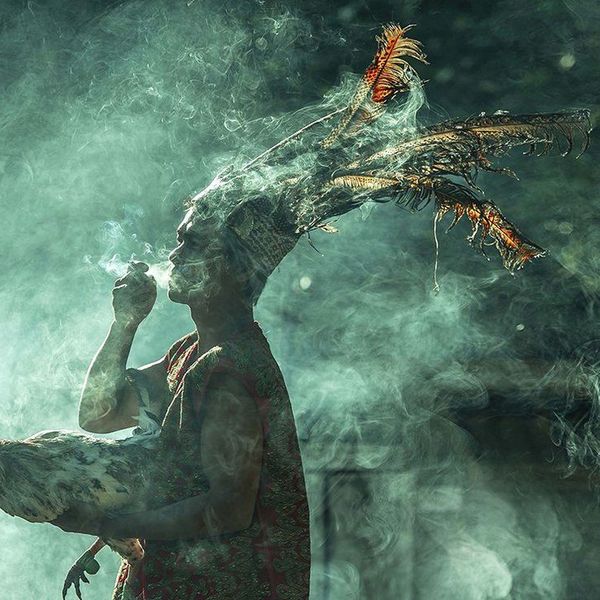Twentieth Century Revolutionary Ideologies
The twentieth century was an important time concerning government. There were two world wars in fifty years, so it is safe to say there were significant ideological differences in the world. The second world war is exemplary of different ideologies clashing, specifically across Europe. The most prominent new ideologies rose and fell relatively quickly: Leninism, Stalinism, the italian brand of fascism, Nazism, and later Maoism.
Let us begin with Leninism. Vladimir Lenin was an admirer of Marx, but differed in some key points that change his position in the triangle. Lenin was, ideologically, a communist. However, he believed that the revolution of the proletariat, the working class that Marx predicted would overthrow the ruling class, had to be helped by a political movement and a political party. In 1917, he played a role in overthrowing the established government of Russia. His policies then began to emulate the ideal communist society. He redistributed land. He nationalized the banks. All of his early policies point to a drive for the ideal of equality.
That being said, Lenin was not a pure communist in this government. The single party rule of the new government, and the events of the Red Terror, which was the mass extermination and subjugation of political opponents, would indicate a leniency toward the order point on the triangle. Lenin had the difficult task of completely transforming his country. This led to him positioning himself, and anyone else who held the same ideological beliefs, at the top of the government. This is not dissimilar to the theory of the golden men that Plato spoke of. The wisest, in Lenin’s opinion, were the people that were ideologically aligned with him. While the policies were communistic, the government bureaucracy was fascist. The social hierarchy of Russia was taken out of the picture, yet the political hierarchy remained. Then, the values of Leninism stray further toward the freedom point on the triangle. The New Economic Policy, which was dubbed “state capitalism”, incorporated a minute amount of autonomy to the private citizens. The government still maintained control on the large sections of the economy, but the smaller enterprises were allowed to be privately owned and managed. It is a small change, but it does make a difference.
In summary, Leninism would fall nearly halfway between order and equality. It leans closer to the equality side. It would be inching, to the point of being almost unnoticeable, toward the free-market ideals of the freedom point. Leninism did not last very long, but it was a politically interesting theory.
Stalinism was the new set of policies that were imposed by Lenin’s successor. Stalin had a different approach to the communist revolution in Russia. He largely abandoned Lenin’s New Economic Plan, and implemented policies that increased centralization and attempted to hasten industrialization. Stalin put the resources of Russia under the control of the government. He thought that Lenin’s economic plan had strayed too far from the ideals of communism.
One might think that this would place Stalinism further toward the equality point of the triangle, but that is not the case. Stalin still had the problem of revolutionizing a country in a spin. He could not run the government through the people in a totally collective manner, and the communist revolution was still a somewhat divisive issue. Stalin’s power shift to complete centralization created a political upper-class. His purges of detractors to his policies created a loyalty of fear in his people, instead of a collectivist faith in the government. He believed that he had to coerce the people into accepting his changes.
In actuality, Stalinism falls more closely to order than Leninism. Once again, it is the issue of the communist golden men. It is a trap into which large-scale communist societies usually fall. In the end, Stalinism is further toward the order point on the triangle, and is significantly farther away from the freedom point.
In Italy, a different political revolution was taking place. Benito Mussolini was an ambitious member of the socialist party in Italy, until he differed from them in policy decisions and was expelled. He went on to form a fascist movement in Italy, and eventually became the prime minister. Italy became a dictatorship and was soon under the rule of Mussolini and his party.
Mussolini began to install his brand of fascism. He immediately gained all legal authority in his country, and instituted a police state. This is particularly in line with the order value on the triangle. He quelled any political dissidence to his state by explicitly outlawing all other political parties. At the point that his power was sufficiently established, he began to take control of the economy. By 1935, he had control of three quarters of the italian economy. He took great pride in the furthering of public works and state control of the economy. His rise to power is marked by the cult he created around himself. This, once again, goes back to the concept of philosopher kings. Instead of intellectualism that galvanized the people’s trust in him, it was powerful posturing that secured him in government.
To the surprise of nobody, Mussolini’s ideological fascism is fairly close to the order point on the triangle. However, it is, in the smallest possible sense, moving toward the freedom point due to Mussolini never gaining complete control of the economy. In another difference, it inches closer to equality due to Mussolini proposing socialization and economic equality in 1944. In essence, it is further toward order than Stalinism, but otherwise in a similar spot.
Nazism is very similar to, and was influenced by, the fascism of Mussolini. Adolf Hitler rose to power in the wake of his country collapsing due to reparations for the first world war. Hitler was angry at the world for doing such things to Germany, and was angry at the German government for simply giving in to the demands. Hitler was impressed by the government that Mussolini had created in Italy, and attempted to emulate it. As soon as he was in a politically advantageous position, he established single party rule over the German government. He began to enact much of the same economic policies that Mussolini did. He had a persistent focus on public works, and had a desire for state-run enterprises.
It all comes together that Nazism is very close to Mussolini’s fascism. It is nearly on the same exact point. However, it would lean slightly further toward order. This is due to the mass subjugation that the Jewish people faced under Hitler, which eventually became a mass extermination campaign under the Nazi government.
After the second world war, a new revolution took place in China. Mao Zedong was a communist revolutionary who wanted to overthrow the ruling class of China. In 1949, he achieved complete political power with the Communist Party of China. He established the single party rule, which was becoming a trend in revolutionary politics.
It goes back, once again, to the idea of the philosopher kings. This is especially true of the cult that Mao created around himself during this time. His policies are very much in line with Stalinism. He placed a large amount of importance on the rapid industrialization of his country. This was a exemplified in his Five-Year Plan, which was an attempt to limit the agrarian nature of the chinese economy, and make a move toward the industry-oriented nature of the modern world. Later in his reign, he attempted the Great Leap Forward. That plan was to massively move toward the communistic ideals of Marx. The plan created communes and forced people into labor on large projects. Furthermore, Mao created a cultural revolution in his own country. The point was to galvanize the youth of China into silencing the opposers to his regime. This is much like the purges of Lenin and Stalin.
Essentially, Maoism is very similar to Stalinism. The state control of the economy, combined with the silencing of political opponents, was an example of the brand of authoritarian communism that was instituted behind these men. Maoism falls very close to the ideology of Stalinism. However, it falls slightly more to equality due to a stronger focus on the communes that were implemented in the Great Leap Forward.
The common trend in these revolutionary ideologies of the twentieth century is the presence of the cult of personality that their leaders managed to create. This is essential to an authoritarian or totalitarian state. This is a trend in most order-oriented societies, which is why most of these ideologies have a tendency toward order. The revolutionary politics of the twentieth century represent a focus on the power of the leader and country. The tumultuous nature of the early twentieth century shows a shift in values during this time. The people became more order-oriented.






















